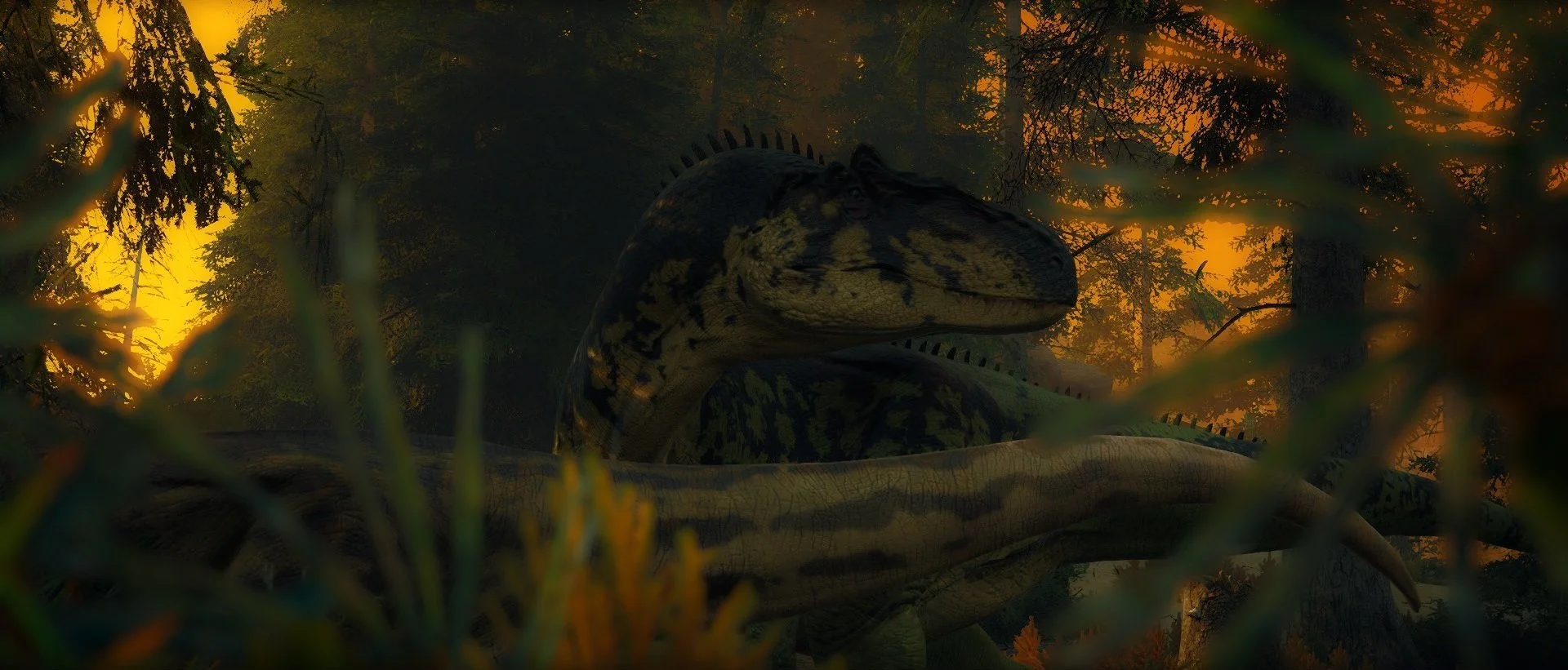Acrocanthosaurus
Tier: 6
Type: Terrestrial carnivore
Passive growth time: 5 hrs 58 min
Pack Size: 3 sub adults/adults, 1-4 juveniles/adolescents
Hierarchy: Kratocracy
Mating bond: Ambiamorous
Nest size: 1-3 offspring per pair
Diet Tags: Carnivore, semi-cannibalistic & non-scavenger
Preferred food: Tier 3-7 herbivores & carnivores
Species specific rules: Must contest other terrestrial apexes for POI. They can also hunt Tier 1-2 herbivores & carnivores if the Tier 1-2 comes within a 1 body length radius, but are not allowed to chase after them.
Can only cannibalize when they have a group of 3.Behaviors in nature
The Acrocanthosaurus can best be described as a frightening hulk of a beast, and this apex predator strides across the plains and stomps through forests as if it is aware of the terror it invokes in all who encounter it. This brash, mighty and muscular creature seems to fear nothing. In fact, the Acrocanthosaurus will usually be found lounging in the shade, cooling its massive frame while sniffing the air in hopes of detecting an opponent arriving for a fight.While lacking speed compared to other creatures, Acrocanthosaurus packs will often roam through their vast territories during the day in hopes of seeking out slower apex herbivores to exhaust and outlast, by using their tough hides as protection against any attacks. Due to their immense mass, Acrocanthosaurus can utilize their weight to deliver forceful stomps, sending shockwaves through the bones of their opponents and forcing them to slow down. Once their unfortunate prey is weakened enough, the most powerful Acrocanthosaurus in the pack, the leader, is granted the right to end their prey’s life. These gluttons will gorge themselves until nothing remains, then continue their routine of lounging together and patrolling their carefully guarded territory in search of more prey to hunt and consume.
Social behavior
Packs of Acrocanthosaurus rely on each other to defend their territory from other apex carnivores. Leadership within the pack is determined by strength rather than gender. Acrocanthosaurus value power and the strongest member typically leads the pack in their hunts. Acrocanthosaurus, being cannibals, are slow to trust. Packs of unknown creatures will often keep some distance between each other and only form bonds out of necessity. Those that have defended the same territory for a long time develop strong platonic bonds with each other and rarely separate. For Acrocanthosaurus, which eats the most dangerous animals on the island, reliable companions are priceless. Friendships between Acrocanthosaurus are known to endure over the entire course of their lives. Even old companions who have joined other packs will bellow a friendly greeting at each other from afar, before continuing on their paths.
Recommended behaviors
╸Acrocanthosaurus dislike deserts and prefer forest and plains biomes where they can find shade trees to lounge under.
╸There is nothing that Acrocanthosaurus likes hearing more than the roar of a Tyrannosaurus. They often have a favorite meal to look forward to when a Tyrannosaurus enters their hunting ground.
╸Acrocanthosaurus will refuse to be near or even look at Lambeosaurus. This is fascinating, as every other predator favors hunting Lambeosaurus
Mating
Acrocanthosaurus are fascinating creatures in that their appearance plays no role in their choice of mates. It is only after proving oneself as a loyal packmate through hunting and fighting side by side that becoming a mate is even considered. Eventually, one Acrocanthosaurus will become their packmate’s favored companion. Often, after surviving many particularly fierce fights together, one Acrocanthosaurus will gently touch their bloodied snout to another’s. If this gesture is returned, both will stand quietly like this, savoring a rare tender moment in their violent lives. This ritual is followed by both partners alternating between sleeping, mating and showing affection through gentle gestures. From that night forward, their bond is so strong that they remain inseparable until death separates them. Acrocanthosaurus, being ambiamorous creatures, may even develop strong bonds with their entire pack, increasing their determination to protect each other and defend their territory. In times of loss, the Acrocanthosaurus is at its most vulnerable state. These creatures grieve deeply and may spend hours by the fallen mate's side. The bond between mates is so strong that when one passes away, the other may soon follow.
Nesting & offspring
The challenging lives of Acrocanthosaurus begin at an early stage. The pair take turns hunting for prey and incubating their eggs, with the nest situated in the heart of their territories. Upon hatching, the young fight to establish a hierarchy among themselves, a necessary part of their upbringing. While this may appear harsh, it is a reflection of the harsh reality of life for an Acrocanthosaurus. The young must understand their place within their group of siblings. Once the hierarchy is established, the young Acrocanthosaurus will form strong bonds that last a lifetime, protecting and supporting each other. Those that show disloyalty to their pack or disregard their place in the sibling kratocracy will often be exiled by their parents, leading to a solitary existence as marauders who engage in violence without restriction. Parents will dote upon their offspring, preparing them for the challenges they will face as they grow. They encourage their children to hunt strong opponents, such as Kelekens or other young abandoned Acrocanthosaurus, to develop their survival instincts. Upon reaching early adulthood, the young Acrocanthosaurus will make their own choice to leave the pack. Usually, siblings will form their own packs until they are ready to find mates.




